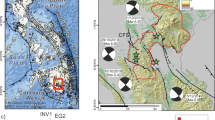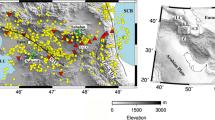Abstract
We examine the initial subevent (ISE) of the M 6.7, 1994 Northridge, California, earthquake in order to discriminate between two end-member rupture initiation models: the ‘preslip’ and ‘cascade’ models. Final earthquake size may be predictable from an ISE's seismic signature in the preslip model but not in the cascade model. In the cascade model ISEs are simply small earthquakes that can be described as purely dynamic ruptures. In this model a large earthquake is triggered by smaller earthquakes; there is no size scaling between triggering and triggered events and a variety of stress transfer mechanisms are possible. Alternatively, in the preslip model, a large earthquake nucleates as an aseismically slipping patch in which the patch dimension grows and scales with the earthquake's ultimate size; the byproduct of this loading process is the ISE. In this model, the duration of the ISE signal scales with the ultimate size of the earthquake, suggesting that nucleation and earthquake size are determined by a more predictable, measurable, and organized process. To distinguish between these two end-member models we use short period seismograms recorded by the Southern California Seismic Network. We address questions regarding the similarity in hypocenter locations and focal mechanisms of the ISE and the mainshock. We also compare the ISE's waveform characteristics to those of small earthquakes and to the beginnings of earthquakes with a range of magnitudes. We find that the focal mechanisms of the ISE and mainshock are indistinguishable, and both events may have nucleated on and ruptured the same fault plane. These results satisfy the requirements for both models and thus do not discriminate between them. However, further tests show the ISE's waveform characteristics are similar to those of typical small earthquakes in the vicinity and more importantly, do not scale with the mainshock magnitude. These results are more consistent with the cascade model.
Similar content being viewed by others
References
Abercrombie, R. and Mori, J., 1994, Local observations of the onset of a large earthquake: 28 June 1992 Landers, California, Bull. Seis. Soc. Am. 84, 725–734.
Abercrombie, R.E., Main, I.G., Douglas, A. and Burton, P.W., 1995a, The nucleation and rupture process of the 1981 Gulf of Corinth earthquakes from deconvolved broad-band data, Geophys. J. Int. 120, 393–405.
Abercrombie, R., Agnew, D. and Wyatt, F., 1995b, Testing a model of earthquake nucleation, Bull. Seis. Soc. Am. 85, 1873–1878.
Abercrombie, R. and Mori, J., 1996, Occurrence patterns of foreshocks to large earthquakes in the western United States, Nature 381, 303–307.
Abramowitz, M. and Stegun, A., 1972, Handbook of Mathematical Functions (9th edn), Dover Publications Inc., New York, N.Y.
Anderson, J.G. and Chen, Q., 1995, Beginnings of earthquakes in the Mexican subduction zone on strong-motion accelerograms, Bull. Seis. Soc. Am. 85, 1107–1115.
Bak, P. and Tang, C., 1989, Earthquakes as a self-organized critical phenomenon, J. Geophys. Res. 94, 15635–15637.
Beroza, G.C. and Ellsworth, W.L., 1996, Properties of the seismic nucleation phase, Tectonophysics 261, 209–277.
Brune, J.N., 1979, Implications of earthquake triggering and rupture propagation for earthquake prediction based on premonitory phenomena, J. Geophys. Res. 84, 2195–2198.
Dodge, D.A., Beroza, G.C. and Ellsworth, W.L., 1996, Detailed observations of California foreshock sequences: Implications for the earthquake initiation process, J. Geophys. Res. 101, 22371–22392.
Dreger, D.S., 1994, Empirical Green's function study of the January 17, 1994 Northridge, California earthquake, Geophys. Res. Lett. 21, 2633–2636.
Ellsworth, W.L. and Beroza, G.C., 1995, Seismic evidence for an earthquake nucleation phase, Science 268, 851–855.
Ellsworth, W.L. and Beroza, G.C., 1998, Observation of the seismic nucleation phase in the Ridgecrest, California, earthquake sequence, Geophys. Res. Lett. 25, 401–404.
Gurrola, H., Baker, G.E. and Minster, J.B., 1995, Simultaneous time-domain deconvolution with application to the computation of receiver functions, Geophys. J. Int. 120, 537–543.
Hearn, T.M., 1984, Pn travel times in Southern California, J. Geophys. Res. 89, 1843–1855.
Hearn, T.M. and Clayton, R.W., 1986, Lateral velocity variations in southern California. II. results for the lower crust from Pn waves, Bull. Seis. Soc. Am. 76, 551–520.
Hearn, T.M., 1996, Anisotropic Pn tomography in the western United States, J. Geophys. Res. 101, 8403–8414.
Iio, Y., 1992, Slow initial phase of the P-wave velocity pulse generated by microearthquakes, Geophys. Res. Lett. 19, 477–480.
Iio, Y., 1995, Observations of the slow initial phase generated by microearthquakes: implications for earthquake nucleation and propagation, J. Geophys. Res. 100, 15333–15349.
Kennett, B.L.N., 1983, Seismic Wave Propagation in Stratified Media, Cambridge University Press, Cambridge.
McGuire, J., Ihmle, P. and Jordan, T., 1996, Time-domain observations of a slow precursor to the 1994 Romanche transform earthquake, Science 274, 82–85.
Mori, J., 1996, Rupture directivity and slip distribution of the M 4.3 Foreshock to the 1992 Joshua Tree Earthquake, Southern California, Bull. Seis. Soc. Am. 86, 805–810.
Mori, J., and Kanamori, H., 1996, Initial rupture of earthquakes in the 1995 Ridgecrest, California sequence, Geophys. Res. Lett. 23, 2437–2440.
Ohnaka, M. and Kuwahara, Y., 1990, Characteristic features of local breakdown near a crack-tip in the transition zone from nucleation to unstable rupture during stick-slip shear failure, Tectonophysics 175, 197–220.
Press, W.H., Flannery, B.P., Teukolsky, S.A. and Vetterling, W.T., 1986, Numerical Recipes: The Art of Scientific Computing, Cambridge University Press, Cambridge.
Randall, G.E. and Taylor, S.R., 1993, Description of a code for computing complete synthetic seismograms in laterally homogeneous layered media.
Reasenberg, P. and Oppenheimer, D., 1985, FPFIT, FPPLOT and FPPAGE: FORTRAN computer programs for calculating and displaying earthquake fault-plane solutions, U.S.G.S. Open File Report, 85–739, 109.
Shibazaki, B. and Matsu'ura, M., 1995, Foreshocks and pre-events associated with the nucleation of large earthquakes, Geophys. Res. Lett. 22, 1305–1308.
Singh, S.K., Ordaz, M., Mikumo, T., Pacheco, J., Valdes, C. and Mandal, P., 1998, Implications of a composite source model and seismic-wave attenuation for the observed simplicity of small earthquakes and reported duration of earthquake initiation phase, Bull. Seis. Soc. Am. 88, 1171–1181.
Sipkin, S.A. and Lerner-Lam, A.L., 1992, Pulse-shape distortion introduced by broadband deconvolution, Bull. Seis. Soc. Am. 82, 238–258.
Steacy, S.J. and McCloskey, J., 1998, What controls an earthquake's size? Results from a heterogeneous cellular automaton, Geophys. J. Int. 133 (1998), F11–F14.
Umeda, Y., 1992, The bright spot of an earthquake, Tectonophysics 211, 13–22.
Vetter, U. and Minster, J.-B., 1981, Pn Velocity anisotropy in southern California, Bull. Seis. Soc. Am. 71, 1511–1530.
Wald, D.J., Heaton, T.H. and Hudnut, K.W., 1996, The slip history of the 1994 Northridge, California, Earthquake determined from strong-motion, teleseismic, GPS and leveling data., Bull. Seis. Soc. Am. 86, S49–S70.
Author information
Authors and Affiliations
Rights and permissions
About this article
Cite this article
Kilb, D., Gomberg, J. The initial subevent of the 1994 Northridge, California, earthquake: Is earthquake size predictable?. Journal of Seismology 3, 409–420 (1999). https://doi.org/10.1023/A:1009890329925
Issue Date:
DOI: https://doi.org/10.1023/A:1009890329925




